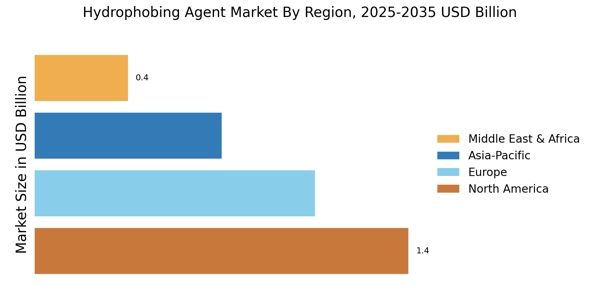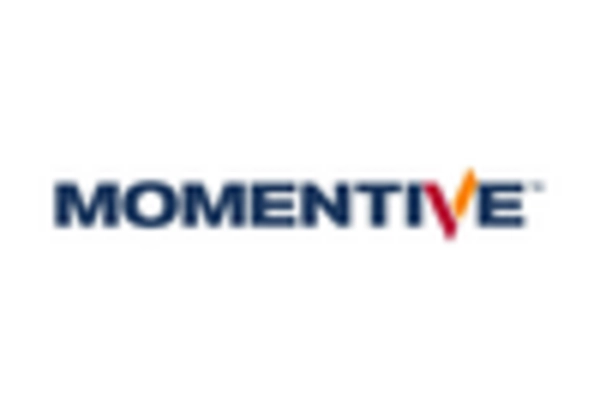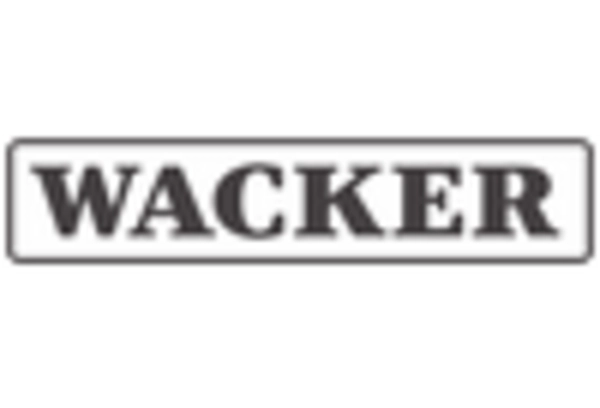Environmental Regulations and Standards
Stringent environmental regulations and standards are increasingly influencing the Hydrophobing Agent Market. Governments are implementing policies aimed at reducing water usage and promoting sustainable practices, which in turn drives the demand for hydrophobing agents. These agents not only enhance the longevity of products but also contribute to water conservation efforts. For example, the construction sector is now required to adhere to specific guidelines that mandate the use of water-repellent materials to minimize environmental impact. This regulatory landscape suggests that companies investing in hydrophobing technologies may gain a competitive edge, as compliance with these standards becomes a critical factor in market success.
Rising Demand for Water-Repellent Solutions
The increasing need for water-repellent solutions across various industries appears to be a primary driver for the Hydrophobing Agent Market. As sectors such as construction, textiles, and automotive seek to enhance product durability and performance, hydrophobing agents are becoming essential. The construction industry, for instance, is projected to grow at a rate of 5.5% annually, leading to heightened demand for hydrophobing agents that protect structures from moisture damage. Additionally, the textile industry is witnessing a shift towards water-resistant fabrics, further propelling the market. This trend indicates a robust growth trajectory for the hydrophobing agent market, as manufacturers strive to meet the evolving needs of consumers and industries alike.
Expanding Applications in Various Industries
The versatility of hydrophobing agents is driving their adoption across a multitude of industries, thereby influencing the Hydrophobing Agent Market. From construction to automotive and textiles, the applications of these agents are diverse and expanding. For instance, in the automotive sector, hydrophobing agents are utilized to enhance the durability of vehicle exteriors against water and dirt. Similarly, in textiles, they are applied to create water-resistant clothing and upholstery. Market analysis suggests that the textile application segment alone is expected to account for approximately 30% of the total market share by 2026. This broad applicability indicates a promising outlook for the hydrophobing agent market as industries increasingly recognize the benefits of water-repellent technologies.
Technological Innovations in Hydrophobing Agents
Technological advancements in the formulation and application of hydrophobing agents are likely to propel the Hydrophobing Agent Market forward. Innovations such as nano-coatings and bio-based hydrophobing agents are emerging, offering enhanced performance and environmental benefits. The introduction of these advanced products is expected to capture the attention of manufacturers seeking to improve product efficacy and sustainability. Market data indicates that the segment of eco-friendly hydrophobing agents is anticipated to grow by 7% annually, reflecting a shift towards greener alternatives. This trend underscores the importance of continuous research and development in maintaining competitiveness within the hydrophobing agent market.
Consumer Awareness and Preference for Quality Products
Growing consumer awareness regarding product quality and longevity is emerging as a significant driver for the Hydrophobing Agent Market. As consumers become more discerning, they increasingly prefer products that offer enhanced durability and resistance to environmental factors. This shift in consumer behavior is prompting manufacturers to incorporate hydrophobing agents into their products to meet these expectations. Market Research Future indicates that approximately 65% of consumers are willing to pay a premium for water-repellent products, highlighting the potential for increased sales in this segment. Consequently, manufacturers are likely to invest more in hydrophobing technologies to align with consumer preferences, thereby fostering growth in the hydrophobing agent market.


















Leave a Comment